Malnutrition Management: An Evidence-Based Approach in Adult Nursing
VerifiedAdded on 2023/06/17
|13
|5039
|213
Essay
AI Summary
This essay explores evidence-based practices in adult nursing for managing malnutrition in elderly patients admitted to hospitals. It begins by introducing the importance of evidence-based practice in nursing, particularly in relation to the NMC (Nursing and Midwifery Council) guidelines. The essay details a literature search conducted using the NICE (National Institute for Health and Care Excellence) database to identify effective nursing interventions for addressing malnutrition in older adults. The search strategy, including keywords and inclusion criteria, is described, followed by a discussion of selected studies and their relevance to nursing practice. Key findings emphasize the role of nurses in conducting nutritional assessments, screenings, and implementing interventions to improve patient outcomes. The essay also highlights the significance of multidisciplinary approaches and the implementation of quality standards to ensure optimal nutritional care for elderly patients at risk of or experiencing malnutrition.
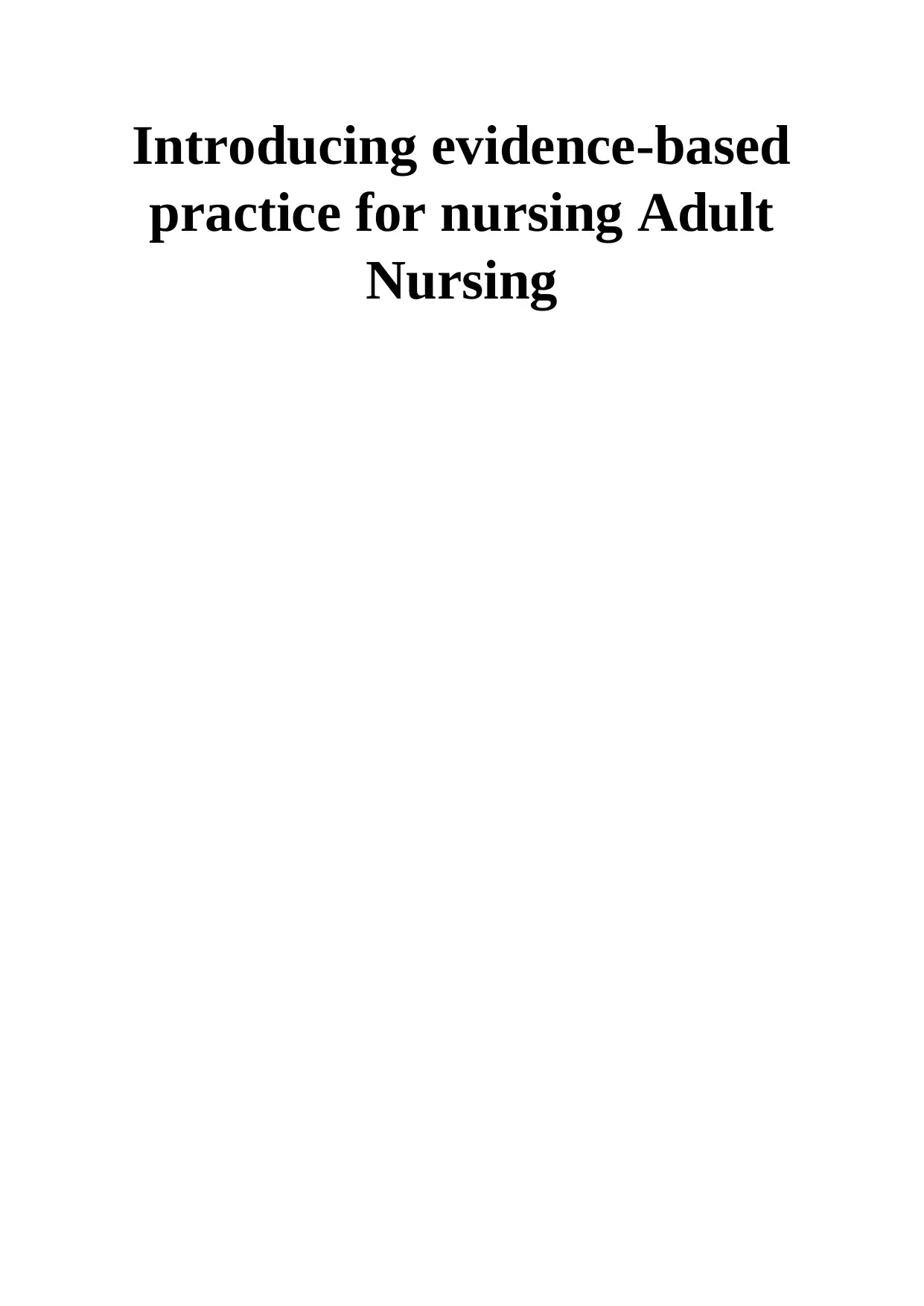
Introducing evidence-based
practice for nursing Adult
Nursing
practice for nursing Adult
Nursing
Paraphrase This Document
Need a fresh take? Get an instant paraphrase of this document with our AI Paraphraser
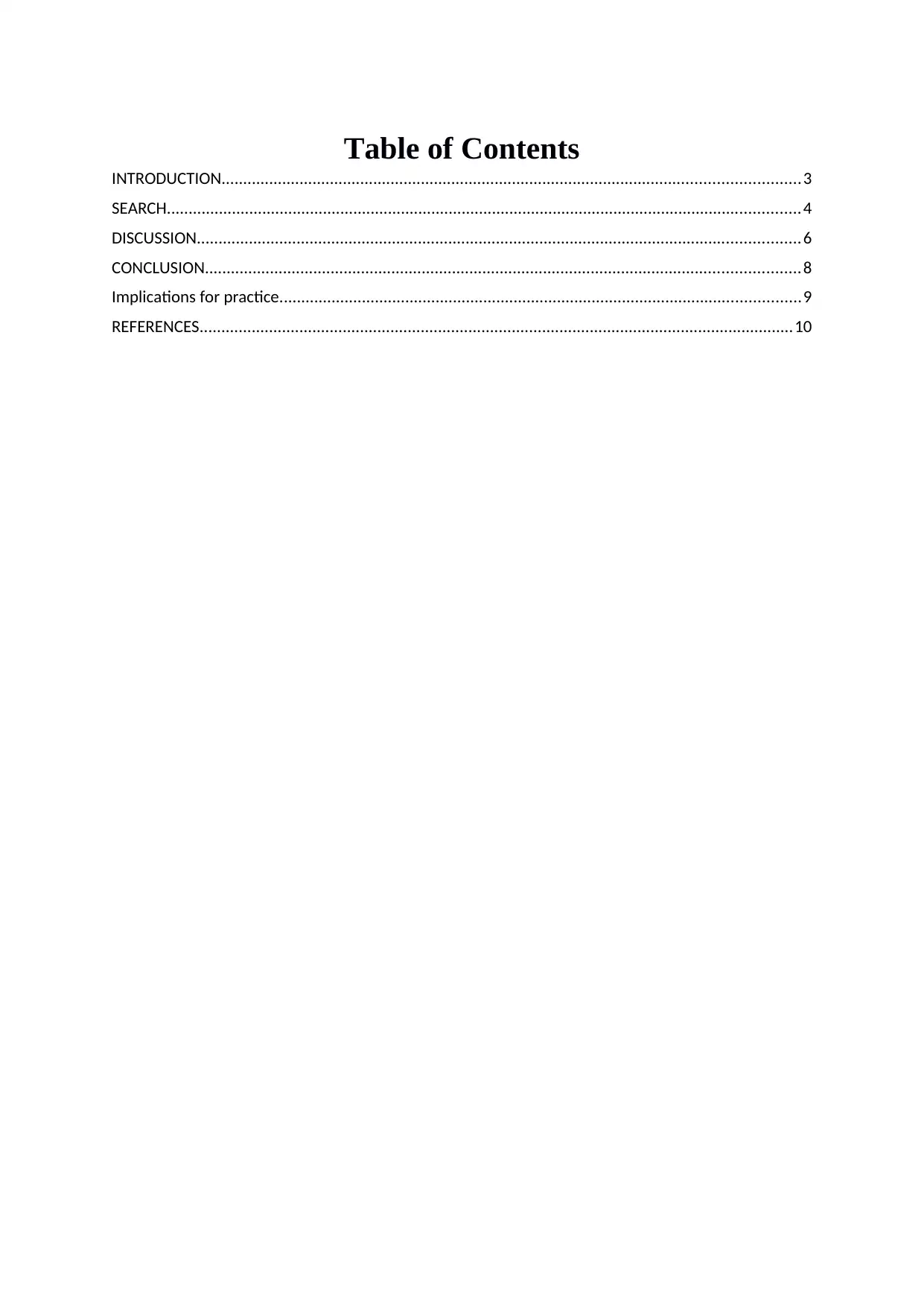
Table of Contents
INTRODUCTION.....................................................................................................................................3
SEARCH..................................................................................................................................................4
DISCUSSION...........................................................................................................................................6
CONCLUSION.........................................................................................................................................8
Implications for practice........................................................................................................................9
REFERENCES.........................................................................................................................................10
INTRODUCTION.....................................................................................................................................3
SEARCH..................................................................................................................................................4
DISCUSSION...........................................................................................................................................6
CONCLUSION.........................................................................................................................................8
Implications for practice........................................................................................................................9
REFERENCES.........................................................................................................................................10
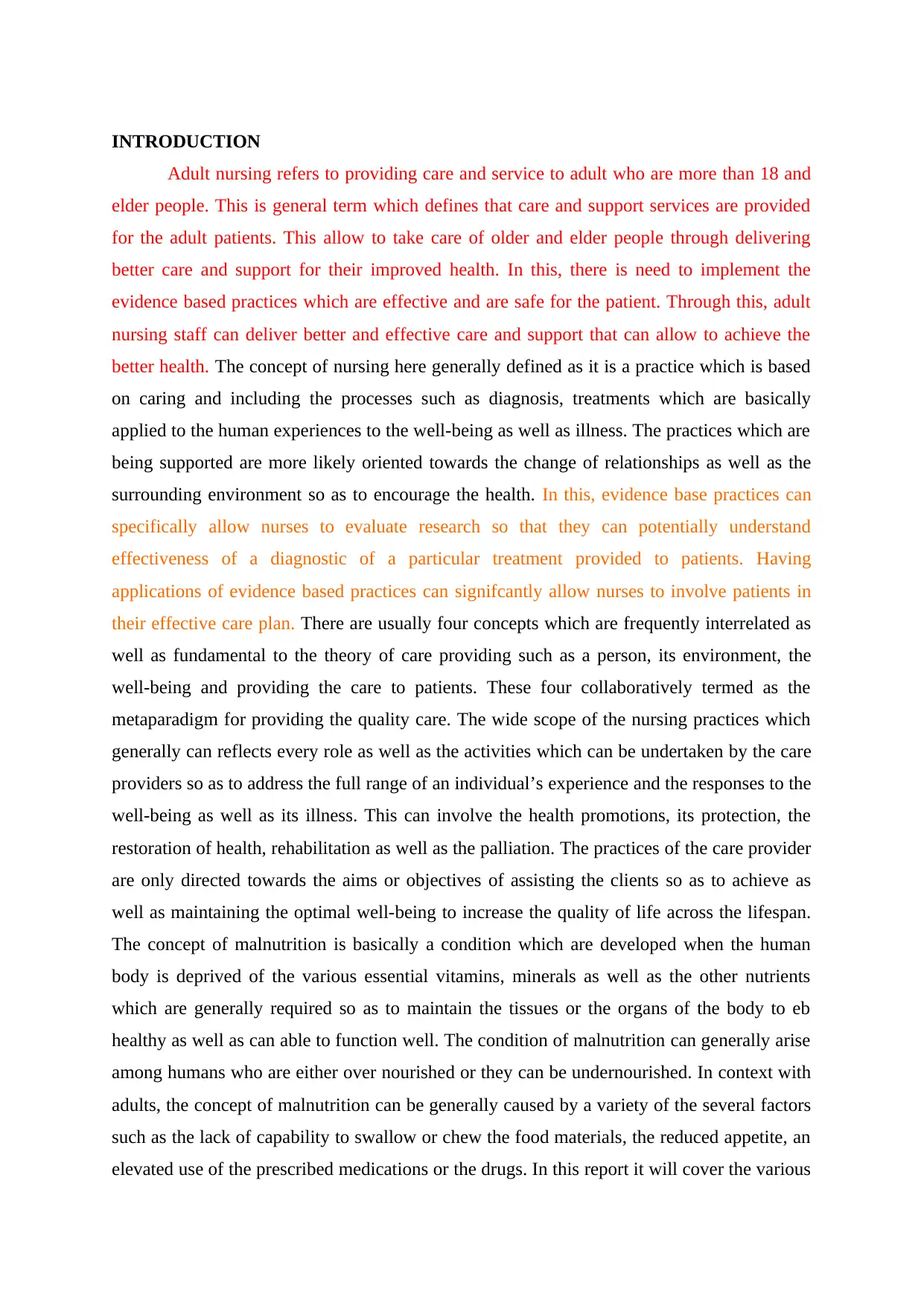
INTRODUCTION
Adult nursing refers to providing care and service to adult who are more than 18 and
elder people. This is general term which defines that care and support services are provided
for the adult patients. This allow to take care of older and elder people through delivering
better care and support for their improved health. In this, there is need to implement the
evidence based practices which are effective and are safe for the patient. Through this, adult
nursing staff can deliver better and effective care and support that can allow to achieve the
better health. The concept of nursing here generally defined as it is a practice which is based
on caring and including the processes such as diagnosis, treatments which are basically
applied to the human experiences to the well-being as well as illness. The practices which are
being supported are more likely oriented towards the change of relationships as well as the
surrounding environment so as to encourage the health. In this, evidence base practices can
specifically allow nurses to evaluate research so that they can potentially understand
effectiveness of a diagnostic of a particular treatment provided to patients. Having
applications of evidence based practices can signifcantly allow nurses to involve patients in
their effective care plan. There are usually four concepts which are frequently interrelated as
well as fundamental to the theory of care providing such as a person, its environment, the
well-being and providing the care to patients. These four collaboratively termed as the
metaparadigm for providing the quality care. The wide scope of the nursing practices which
generally can reflects every role as well as the activities which can be undertaken by the care
providers so as to address the full range of an individual’s experience and the responses to the
well-being as well as its illness. This can involve the health promotions, its protection, the
restoration of health, rehabilitation as well as the palliation. The practices of the care provider
are only directed towards the aims or objectives of assisting the clients so as to achieve as
well as maintaining the optimal well-being to increase the quality of life across the lifespan.
The concept of malnutrition is basically a condition which are developed when the human
body is deprived of the various essential vitamins, minerals as well as the other nutrients
which are generally required so as to maintain the tissues or the organs of the body to eb
healthy as well as can able to function well. The condition of malnutrition can generally arise
among humans who are either over nourished or they can be undernourished. In context with
adults, the concept of malnutrition can be generally caused by a variety of the several factors
such as the lack of capability to swallow or chew the food materials, the reduced appetite, an
elevated use of the prescribed medications or the drugs. In this report it will cover the various
Adult nursing refers to providing care and service to adult who are more than 18 and
elder people. This is general term which defines that care and support services are provided
for the adult patients. This allow to take care of older and elder people through delivering
better care and support for their improved health. In this, there is need to implement the
evidence based practices which are effective and are safe for the patient. Through this, adult
nursing staff can deliver better and effective care and support that can allow to achieve the
better health. The concept of nursing here generally defined as it is a practice which is based
on caring and including the processes such as diagnosis, treatments which are basically
applied to the human experiences to the well-being as well as illness. The practices which are
being supported are more likely oriented towards the change of relationships as well as the
surrounding environment so as to encourage the health. In this, evidence base practices can
specifically allow nurses to evaluate research so that they can potentially understand
effectiveness of a diagnostic of a particular treatment provided to patients. Having
applications of evidence based practices can signifcantly allow nurses to involve patients in
their effective care plan. There are usually four concepts which are frequently interrelated as
well as fundamental to the theory of care providing such as a person, its environment, the
well-being and providing the care to patients. These four collaboratively termed as the
metaparadigm for providing the quality care. The wide scope of the nursing practices which
generally can reflects every role as well as the activities which can be undertaken by the care
providers so as to address the full range of an individual’s experience and the responses to the
well-being as well as its illness. This can involve the health promotions, its protection, the
restoration of health, rehabilitation as well as the palliation. The practices of the care provider
are only directed towards the aims or objectives of assisting the clients so as to achieve as
well as maintaining the optimal well-being to increase the quality of life across the lifespan.
The concept of malnutrition is basically a condition which are developed when the human
body is deprived of the various essential vitamins, minerals as well as the other nutrients
which are generally required so as to maintain the tissues or the organs of the body to eb
healthy as well as can able to function well. The condition of malnutrition can generally arise
among humans who are either over nourished or they can be undernourished. In context with
adults, the concept of malnutrition can be generally caused by a variety of the several factors
such as the lack of capability to swallow or chew the food materials, the reduced appetite, an
elevated use of the prescribed medications or the drugs. In this report it will cover the various
⊘ This is a preview!⊘
Do you want full access?
Subscribe today to unlock all pages.

Trusted by 1+ million students worldwide
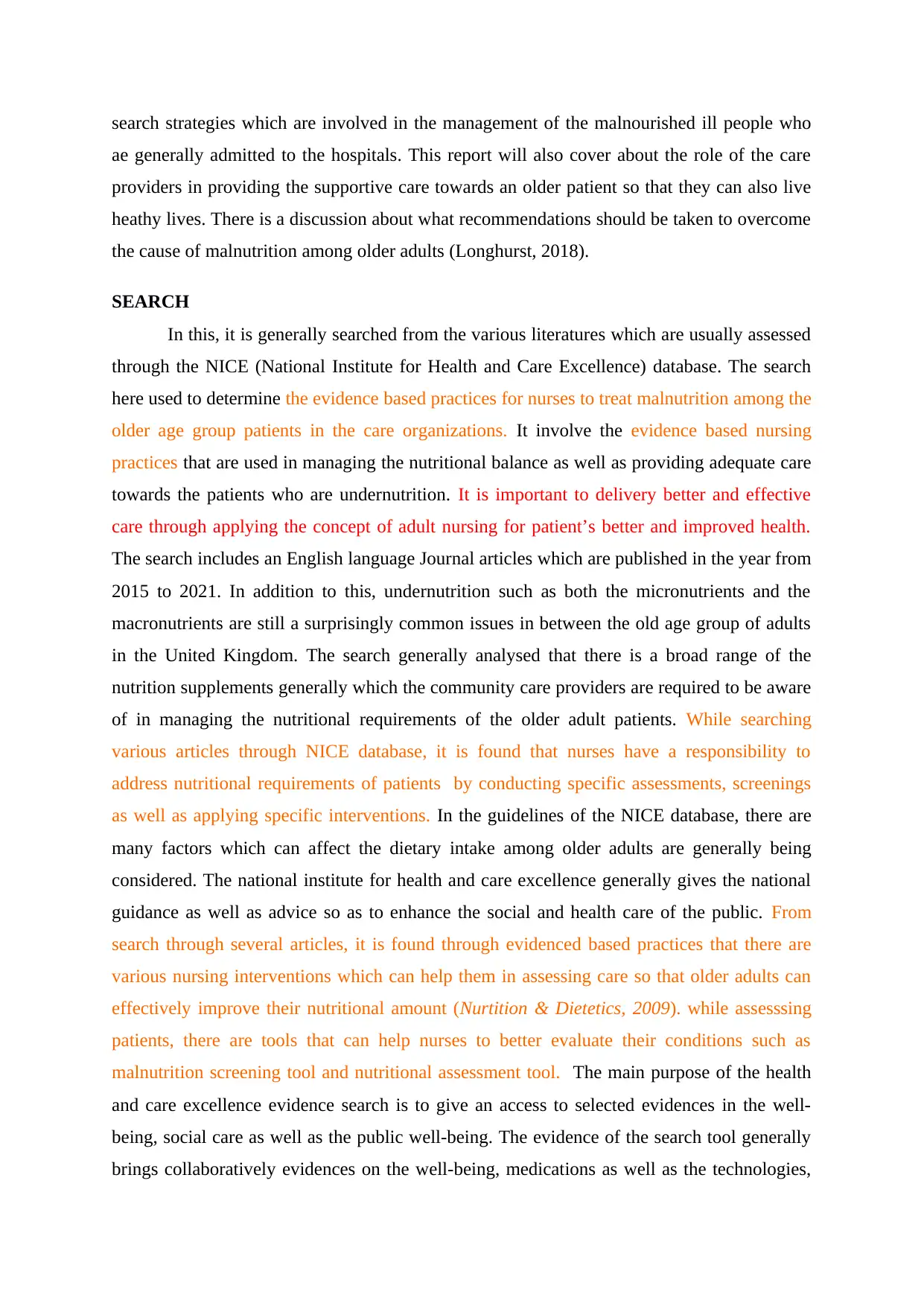
search strategies which are involved in the management of the malnourished ill people who
ae generally admitted to the hospitals. This report will also cover about the role of the care
providers in providing the supportive care towards an older patient so that they can also live
heathy lives. There is a discussion about what recommendations should be taken to overcome
the cause of malnutrition among older adults (Longhurst, 2018).
SEARCH
In this, it is generally searched from the various literatures which are usually assessed
through the NICE (National Institute for Health and Care Excellence) database. The search
here used to determine the evidence based practices for nurses to treat malnutrition among the
older age group patients in the care organizations. It involve the evidence based nursing
practices that are used in managing the nutritional balance as well as providing adequate care
towards the patients who are undernutrition. It is important to delivery better and effective
care through applying the concept of adult nursing for patient’s better and improved health.
The search includes an English language Journal articles which are published in the year from
2015 to 2021. In addition to this, undernutrition such as both the micronutrients and the
macronutrients are still a surprisingly common issues in between the old age group of adults
in the United Kingdom. The search generally analysed that there is a broad range of the
nutrition supplements generally which the community care providers are required to be aware
of in managing the nutritional requirements of the older adult patients. While searching
various articles through NICE database, it is found that nurses have a responsibility to
address nutritional requirements of patients by conducting specific assessments, screenings
as well as applying specific interventions. In the guidelines of the NICE database, there are
many factors which can affect the dietary intake among older adults are generally being
considered. The national institute for health and care excellence generally gives the national
guidance as well as advice so as to enhance the social and health care of the public. From
search through several articles, it is found through evidenced based practices that there are
various nursing interventions which can help them in assessing care so that older adults can
effectively improve their nutritional amount (Nurtition & Dietetics, 2009). while assesssing
patients, there are tools that can help nurses to better evaluate their conditions such as
malnutrition screening tool and nutritional assessment tool. The main purpose of the health
and care excellence evidence search is to give an access to selected evidences in the well-
being, social care as well as the public well-being. The evidence of the search tool generally
brings collaboratively evidences on the well-being, medications as well as the technologies,
ae generally admitted to the hospitals. This report will also cover about the role of the care
providers in providing the supportive care towards an older patient so that they can also live
heathy lives. There is a discussion about what recommendations should be taken to overcome
the cause of malnutrition among older adults (Longhurst, 2018).
SEARCH
In this, it is generally searched from the various literatures which are usually assessed
through the NICE (National Institute for Health and Care Excellence) database. The search
here used to determine the evidence based practices for nurses to treat malnutrition among the
older age group patients in the care organizations. It involve the evidence based nursing
practices that are used in managing the nutritional balance as well as providing adequate care
towards the patients who are undernutrition. It is important to delivery better and effective
care through applying the concept of adult nursing for patient’s better and improved health.
The search includes an English language Journal articles which are published in the year from
2015 to 2021. In addition to this, undernutrition such as both the micronutrients and the
macronutrients are still a surprisingly common issues in between the old age group of adults
in the United Kingdom. The search generally analysed that there is a broad range of the
nutrition supplements generally which the community care providers are required to be aware
of in managing the nutritional requirements of the older adult patients. While searching
various articles through NICE database, it is found that nurses have a responsibility to
address nutritional requirements of patients by conducting specific assessments, screenings
as well as applying specific interventions. In the guidelines of the NICE database, there are
many factors which can affect the dietary intake among older adults are generally being
considered. The national institute for health and care excellence generally gives the national
guidance as well as advice so as to enhance the social and health care of the public. From
search through several articles, it is found through evidenced based practices that there are
various nursing interventions which can help them in assessing care so that older adults can
effectively improve their nutritional amount (Nurtition & Dietetics, 2009). while assesssing
patients, there are tools that can help nurses to better evaluate their conditions such as
malnutrition screening tool and nutritional assessment tool. The main purpose of the health
and care excellence evidence search is to give an access to selected evidences in the well-
being, social care as well as the public well-being. The evidence of the search tool generally
brings collaboratively evidences on the well-being, medications as well as the technologies,
Paraphrase This Document
Need a fresh take? Get an instant paraphrase of this document with our AI Paraphraser
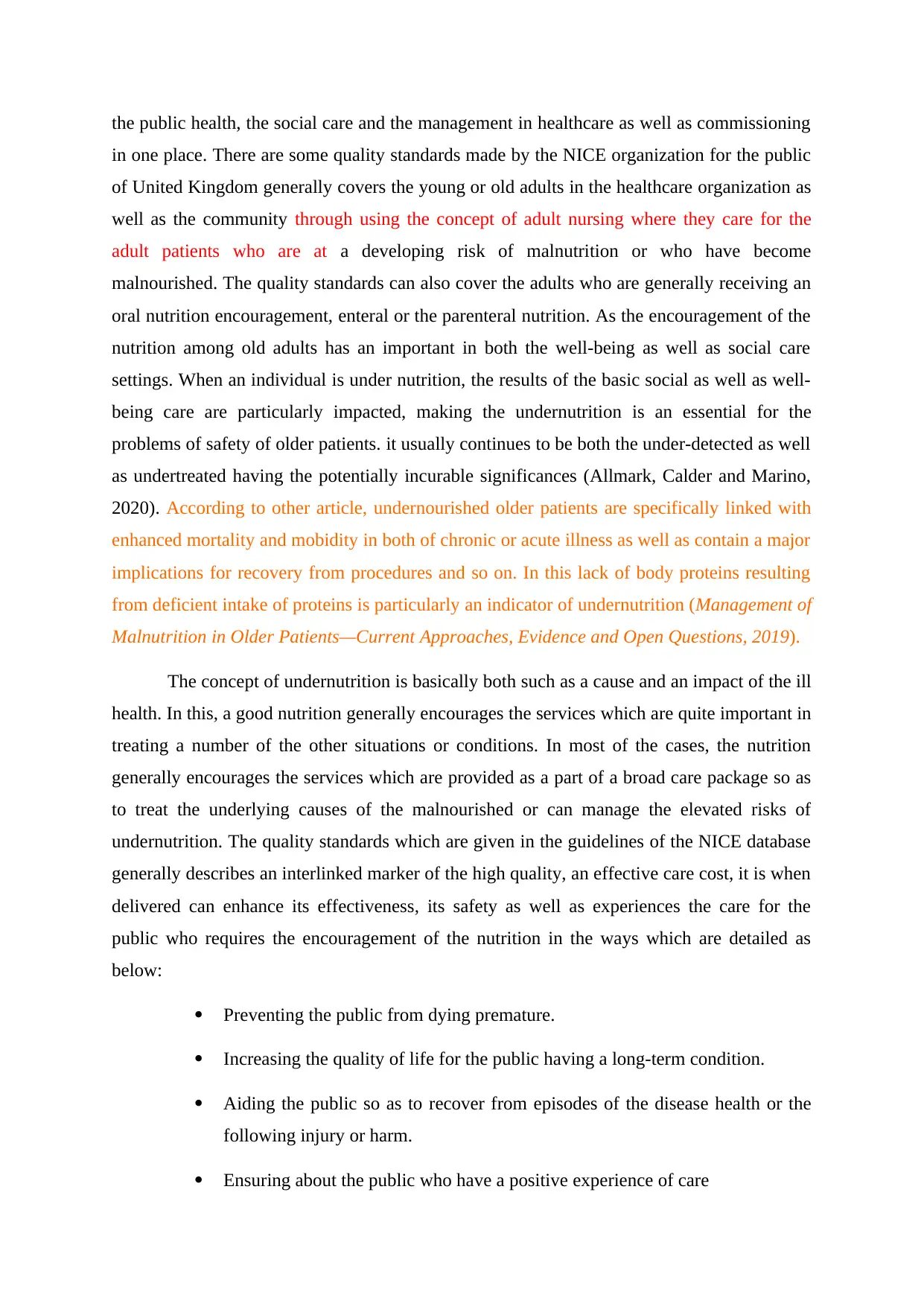
the public health, the social care and the management in healthcare as well as commissioning
in one place. There are some quality standards made by the NICE organization for the public
of United Kingdom generally covers the young or old adults in the healthcare organization as
well as the community through using the concept of adult nursing where they care for the
adult patients who are at a developing risk of malnutrition or who have become
malnourished. The quality standards can also cover the adults who are generally receiving an
oral nutrition encouragement, enteral or the parenteral nutrition. As the encouragement of the
nutrition among old adults has an important in both the well-being as well as social care
settings. When an individual is under nutrition, the results of the basic social as well as well-
being care are particularly impacted, making the undernutrition is an essential for the
problems of safety of older patients. it usually continues to be both the under-detected as well
as undertreated having the potentially incurable significances (Allmark, Calder and Marino,
2020). According to other article, undernourished older patients are specifically linked with
enhanced mortality and mobidity in both of chronic or acute illness as well as contain a major
implications for recovery from procedures and so on. In this lack of body proteins resulting
from deficient intake of proteins is particularly an indicator of undernutrition (Management of
Malnutrition in Older Patients—Current Approaches, Evidence and Open Questions, 2019).
The concept of undernutrition is basically both such as a cause and an impact of the ill
health. In this, a good nutrition generally encourages the services which are quite important in
treating a number of the other situations or conditions. In most of the cases, the nutrition
generally encourages the services which are provided as a part of a broad care package so as
to treat the underlying causes of the malnourished or can manage the elevated risks of
undernutrition. The quality standards which are given in the guidelines of the NICE database
generally describes an interlinked marker of the high quality, an effective care cost, it is when
delivered can enhance its effectiveness, its safety as well as experiences the care for the
public who requires the encouragement of the nutrition in the ways which are detailed as
below:
Preventing the public from dying premature.
Increasing the quality of life for the public having a long-term condition.
Aiding the public so as to recover from episodes of the disease health or the
following injury or harm.
Ensuring about the public who have a positive experience of care
in one place. There are some quality standards made by the NICE organization for the public
of United Kingdom generally covers the young or old adults in the healthcare organization as
well as the community through using the concept of adult nursing where they care for the
adult patients who are at a developing risk of malnutrition or who have become
malnourished. The quality standards can also cover the adults who are generally receiving an
oral nutrition encouragement, enteral or the parenteral nutrition. As the encouragement of the
nutrition among old adults has an important in both the well-being as well as social care
settings. When an individual is under nutrition, the results of the basic social as well as well-
being care are particularly impacted, making the undernutrition is an essential for the
problems of safety of older patients. it usually continues to be both the under-detected as well
as undertreated having the potentially incurable significances (Allmark, Calder and Marino,
2020). According to other article, undernourished older patients are specifically linked with
enhanced mortality and mobidity in both of chronic or acute illness as well as contain a major
implications for recovery from procedures and so on. In this lack of body proteins resulting
from deficient intake of proteins is particularly an indicator of undernutrition (Management of
Malnutrition in Older Patients—Current Approaches, Evidence and Open Questions, 2019).
The concept of undernutrition is basically both such as a cause and an impact of the ill
health. In this, a good nutrition generally encourages the services which are quite important in
treating a number of the other situations or conditions. In most of the cases, the nutrition
generally encourages the services which are provided as a part of a broad care package so as
to treat the underlying causes of the malnourished or can manage the elevated risks of
undernutrition. The quality standards which are given in the guidelines of the NICE database
generally describes an interlinked marker of the high quality, an effective care cost, it is when
delivered can enhance its effectiveness, its safety as well as experiences the care for the
public who requires the encouragement of the nutrition in the ways which are detailed as
below:
Preventing the public from dying premature.
Increasing the quality of life for the public having a long-term condition.
Aiding the public so as to recover from episodes of the disease health or the
following injury or harm.
Ensuring about the public who have a positive experience of care

Treating as well as caring for the public in a safe surrounding environment as
well as protecting the people from an avoidable harm.
In addition to this, the quality standards which are established in terms of encourage
the older adults generally needed adult nursing which allow to get care services take the
responsibilities for the determination of the public who are at a developing risk of
undernutrition or malnutrition. It also gives the empowerment for every old age group who
requires it. In this, an integrated approach to the provision of the services is generally a
fundamental to the delivery of the high-quality care among the old age group who generally
requires the support of nutrition. It is specifically essential that the empowerment services of
the nutrition are the multidisciplinary and are overseen as well as generally commanded by
the senior level staff from the settings such as through the nutrition routing groups or the
committees. The quality standards are must be read in the context of the national as well as
the local guidelines on the training and competencies. An implementation of these such
quality standards is dependent on all the care professionals who are involved in giving the
support of nutrition to the old age groups where adult nursing staff deliver effective care and
support. Adult nursing staffs are being suitably trained as well as are competent to deliver the
actions as well as the interventions which are already illustrated in the quality standards
(Baillie, 2020).
DISCUSSION
It is determined from the study that an optimal amount of the nutrition in the health
care organization is necessary for the old age group patients where adult nursing staff take
care and play their role and responsibility. It can generally facilitate the better outcomes of
the patients. the malnourished or undernutrition in the healthcare patients can usually leads to
the low or poor wound healing as well as impaired functions of the immune system which
can results in the infection or contamination complications or issues. Sometimes, it can also
lead to the long stays in the healthcare organizations and can ultimately enhances the
mortality as well as morbidity rates. It is analysed that the prevalence of the undernutrition
generally has been reported in approximately about 50% of the admitted old age group
patients and needed adult nursing staff. in this, the prior screening for the nutritional risk can
generally enables for an appropriate intervention among the health care organizations and can
also plan for an appropriate home service as well as follow up for outpatient nutritional care.
The health care organizations can generally use a multidisciplinary factor or approaches so as
to evaluate as well as can address the requirements of the nutritional components of the
well as protecting the people from an avoidable harm.
In addition to this, the quality standards which are established in terms of encourage
the older adults generally needed adult nursing which allow to get care services take the
responsibilities for the determination of the public who are at a developing risk of
undernutrition or malnutrition. It also gives the empowerment for every old age group who
requires it. In this, an integrated approach to the provision of the services is generally a
fundamental to the delivery of the high-quality care among the old age group who generally
requires the support of nutrition. It is specifically essential that the empowerment services of
the nutrition are the multidisciplinary and are overseen as well as generally commanded by
the senior level staff from the settings such as through the nutrition routing groups or the
committees. The quality standards are must be read in the context of the national as well as
the local guidelines on the training and competencies. An implementation of these such
quality standards is dependent on all the care professionals who are involved in giving the
support of nutrition to the old age groups where adult nursing staff deliver effective care and
support. Adult nursing staffs are being suitably trained as well as are competent to deliver the
actions as well as the interventions which are already illustrated in the quality standards
(Baillie, 2020).
DISCUSSION
It is determined from the study that an optimal amount of the nutrition in the health
care organization is necessary for the old age group patients where adult nursing staff take
care and play their role and responsibility. It can generally facilitate the better outcomes of
the patients. the malnourished or undernutrition in the healthcare patients can usually leads to
the low or poor wound healing as well as impaired functions of the immune system which
can results in the infection or contamination complications or issues. Sometimes, it can also
lead to the long stays in the healthcare organizations and can ultimately enhances the
mortality as well as morbidity rates. It is analysed that the prevalence of the undernutrition
generally has been reported in approximately about 50% of the admitted old age group
patients and needed adult nursing staff. in this, the prior screening for the nutritional risk can
generally enables for an appropriate intervention among the health care organizations and can
also plan for an appropriate home service as well as follow up for outpatient nutritional care.
The health care organizations can generally use a multidisciplinary factor or approaches so as
to evaluate as well as can address the requirements of the nutritional components of the
⊘ This is a preview!⊘
Do you want full access?
Subscribe today to unlock all pages.

Trusted by 1+ million students worldwide
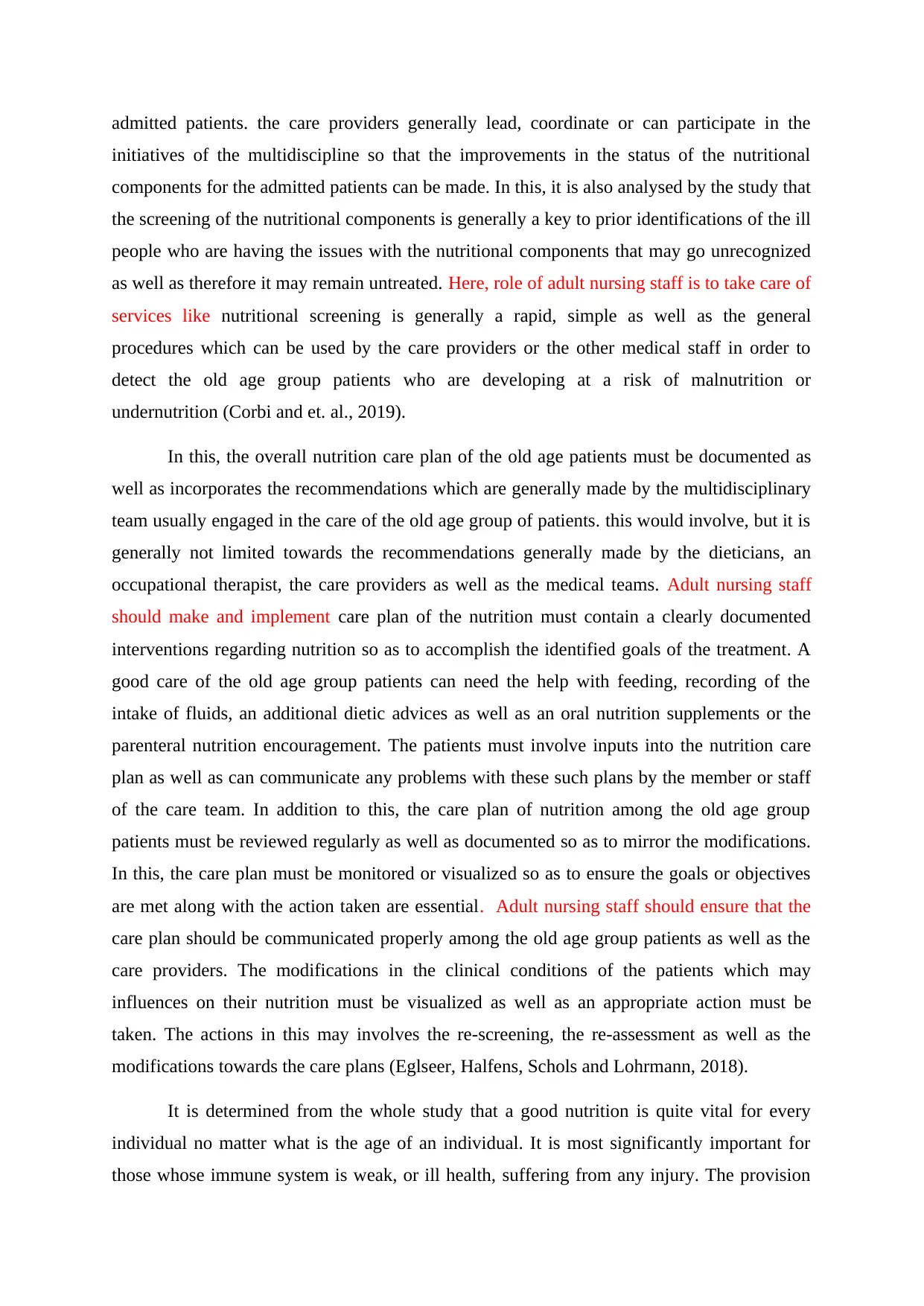
admitted patients. the care providers generally lead, coordinate or can participate in the
initiatives of the multidiscipline so that the improvements in the status of the nutritional
components for the admitted patients can be made. In this, it is also analysed by the study that
the screening of the nutritional components is generally a key to prior identifications of the ill
people who are having the issues with the nutritional components that may go unrecognized
as well as therefore it may remain untreated. Here, role of adult nursing staff is to take care of
services like nutritional screening is generally a rapid, simple as well as the general
procedures which can be used by the care providers or the other medical staff in order to
detect the old age group patients who are developing at a risk of malnutrition or
undernutrition (Corbi and et. al., 2019).
In this, the overall nutrition care plan of the old age patients must be documented as
well as incorporates the recommendations which are generally made by the multidisciplinary
team usually engaged in the care of the old age group of patients. this would involve, but it is
generally not limited towards the recommendations generally made by the dieticians, an
occupational therapist, the care providers as well as the medical teams. Adult nursing staff
should make and implement care plan of the nutrition must contain a clearly documented
interventions regarding nutrition so as to accomplish the identified goals of the treatment. A
good care of the old age group patients can need the help with feeding, recording of the
intake of fluids, an additional dietic advices as well as an oral nutrition supplements or the
parenteral nutrition encouragement. The patients must involve inputs into the nutrition care
plan as well as can communicate any problems with these such plans by the member or staff
of the care team. In addition to this, the care plan of nutrition among the old age group
patients must be reviewed regularly as well as documented so as to mirror the modifications.
In this, the care plan must be monitored or visualized so as to ensure the goals or objectives
are met along with the action taken are essential. Adult nursing staff should ensure that the
care plan should be communicated properly among the old age group patients as well as the
care providers. The modifications in the clinical conditions of the patients which may
influences on their nutrition must be visualized as well as an appropriate action must be
taken. The actions in this may involves the re-screening, the re-assessment as well as the
modifications towards the care plans (Eglseer, Halfens, Schols and Lohrmann, 2018).
It is determined from the whole study that a good nutrition is quite vital for every
individual no matter what is the age of an individual. It is most significantly important for
those whose immune system is weak, or ill health, suffering from any injury. The provision
initiatives of the multidiscipline so that the improvements in the status of the nutritional
components for the admitted patients can be made. In this, it is also analysed by the study that
the screening of the nutritional components is generally a key to prior identifications of the ill
people who are having the issues with the nutritional components that may go unrecognized
as well as therefore it may remain untreated. Here, role of adult nursing staff is to take care of
services like nutritional screening is generally a rapid, simple as well as the general
procedures which can be used by the care providers or the other medical staff in order to
detect the old age group patients who are developing at a risk of malnutrition or
undernutrition (Corbi and et. al., 2019).
In this, the overall nutrition care plan of the old age patients must be documented as
well as incorporates the recommendations which are generally made by the multidisciplinary
team usually engaged in the care of the old age group of patients. this would involve, but it is
generally not limited towards the recommendations generally made by the dieticians, an
occupational therapist, the care providers as well as the medical teams. Adult nursing staff
should make and implement care plan of the nutrition must contain a clearly documented
interventions regarding nutrition so as to accomplish the identified goals of the treatment. A
good care of the old age group patients can need the help with feeding, recording of the
intake of fluids, an additional dietic advices as well as an oral nutrition supplements or the
parenteral nutrition encouragement. The patients must involve inputs into the nutrition care
plan as well as can communicate any problems with these such plans by the member or staff
of the care team. In addition to this, the care plan of nutrition among the old age group
patients must be reviewed regularly as well as documented so as to mirror the modifications.
In this, the care plan must be monitored or visualized so as to ensure the goals or objectives
are met along with the action taken are essential. Adult nursing staff should ensure that the
care plan should be communicated properly among the old age group patients as well as the
care providers. The modifications in the clinical conditions of the patients which may
influences on their nutrition must be visualized as well as an appropriate action must be
taken. The actions in this may involves the re-screening, the re-assessment as well as the
modifications towards the care plans (Eglseer, Halfens, Schols and Lohrmann, 2018).
It is determined from the whole study that a good nutrition is quite vital for every
individual no matter what is the age of an individual. It is most significantly important for
those whose immune system is weak, or ill health, suffering from any injury. The provision
Paraphrase This Document
Need a fresh take? Get an instant paraphrase of this document with our AI Paraphraser
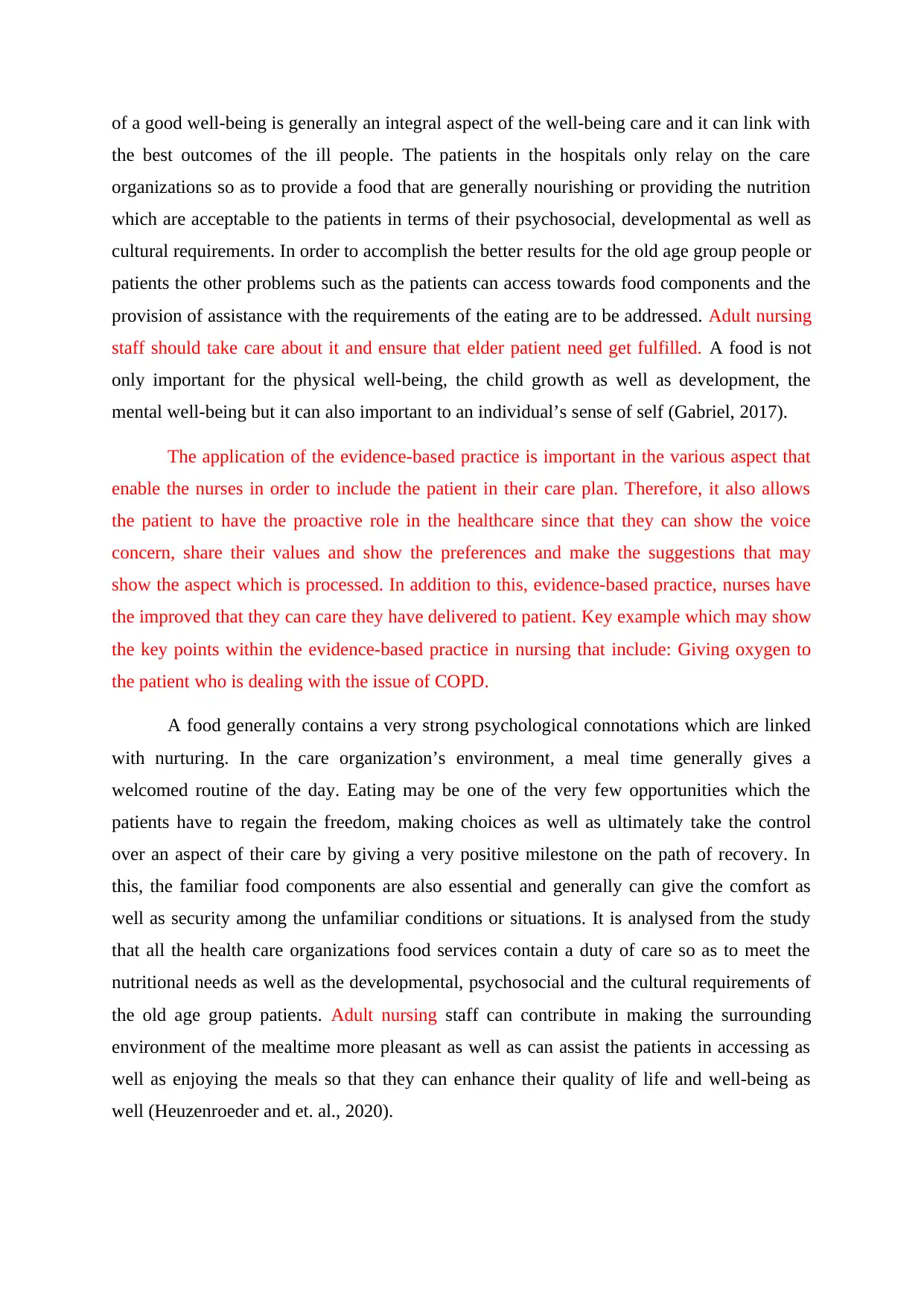
of a good well-being is generally an integral aspect of the well-being care and it can link with
the best outcomes of the ill people. The patients in the hospitals only relay on the care
organizations so as to provide a food that are generally nourishing or providing the nutrition
which are acceptable to the patients in terms of their psychosocial, developmental as well as
cultural requirements. In order to accomplish the better results for the old age group people or
patients the other problems such as the patients can access towards food components and the
provision of assistance with the requirements of the eating are to be addressed. Adult nursing
staff should take care about it and ensure that elder patient need get fulfilled. A food is not
only important for the physical well-being, the child growth as well as development, the
mental well-being but it can also important to an individual’s sense of self (Gabriel, 2017).
The application of the evidence-based practice is important in the various aspect that
enable the nurses in order to include the patient in their care plan. Therefore, it also allows
the patient to have the proactive role in the healthcare since that they can show the voice
concern, share their values and show the preferences and make the suggestions that may
show the aspect which is processed. In addition to this, evidence-based practice, nurses have
the improved that they can care they have delivered to patient. Key example which may show
the key points within the evidence-based practice in nursing that include: Giving oxygen to
the patient who is dealing with the issue of COPD.
A food generally contains a very strong psychological connotations which are linked
with nurturing. In the care organization’s environment, a meal time generally gives a
welcomed routine of the day. Eating may be one of the very few opportunities which the
patients have to regain the freedom, making choices as well as ultimately take the control
over an aspect of their care by giving a very positive milestone on the path of recovery. In
this, the familiar food components are also essential and generally can give the comfort as
well as security among the unfamiliar conditions or situations. It is analysed from the study
that all the health care organizations food services contain a duty of care so as to meet the
nutritional needs as well as the developmental, psychosocial and the cultural requirements of
the old age group patients. Adult nursing staff can contribute in making the surrounding
environment of the mealtime more pleasant as well as can assist the patients in accessing as
well as enjoying the meals so that they can enhance their quality of life and well-being as
well (Heuzenroeder and et. al., 2020).
the best outcomes of the ill people. The patients in the hospitals only relay on the care
organizations so as to provide a food that are generally nourishing or providing the nutrition
which are acceptable to the patients in terms of their psychosocial, developmental as well as
cultural requirements. In order to accomplish the better results for the old age group people or
patients the other problems such as the patients can access towards food components and the
provision of assistance with the requirements of the eating are to be addressed. Adult nursing
staff should take care about it and ensure that elder patient need get fulfilled. A food is not
only important for the physical well-being, the child growth as well as development, the
mental well-being but it can also important to an individual’s sense of self (Gabriel, 2017).
The application of the evidence-based practice is important in the various aspect that
enable the nurses in order to include the patient in their care plan. Therefore, it also allows
the patient to have the proactive role in the healthcare since that they can show the voice
concern, share their values and show the preferences and make the suggestions that may
show the aspect which is processed. In addition to this, evidence-based practice, nurses have
the improved that they can care they have delivered to patient. Key example which may show
the key points within the evidence-based practice in nursing that include: Giving oxygen to
the patient who is dealing with the issue of COPD.
A food generally contains a very strong psychological connotations which are linked
with nurturing. In the care organization’s environment, a meal time generally gives a
welcomed routine of the day. Eating may be one of the very few opportunities which the
patients have to regain the freedom, making choices as well as ultimately take the control
over an aspect of their care by giving a very positive milestone on the path of recovery. In
this, the familiar food components are also essential and generally can give the comfort as
well as security among the unfamiliar conditions or situations. It is analysed from the study
that all the health care organizations food services contain a duty of care so as to meet the
nutritional needs as well as the developmental, psychosocial and the cultural requirements of
the old age group patients. Adult nursing staff can contribute in making the surrounding
environment of the mealtime more pleasant as well as can assist the patients in accessing as
well as enjoying the meals so that they can enhance their quality of life and well-being as
well (Heuzenroeder and et. al., 2020).

CONCLUSION
The projected enhances in the number of the older adults with a frailty can underlines
the necessity of addressing the malnutrition. So, as to enhance the well-being among the older
age group there is need to delivery better care and support from the adult nursing staff. The
lack of an agreed standardized methods so as to screen for the developing risk of the
malnutrition among the older adult patients in the health care organizations will keep to prove
a challenge when attempting a broad scale of screening as well as the treatment initiative
which are taken and measuring an accurate prevalence rate as well to improve the well-being
among particular group. A complex mixture of the factors can generally make impact of the
nutrition among older adult age groups but there are some constituents of the daily practice in
between the healthcare organizations or the society settings that could be enhanced so as to
address the malnutrition. Adult nursing staff member should involve in essential role in
addressing some of these challenges by growing the awareness of the problems involving the
malnutrition among the older adult age groups.
In this, it can involve the improvement of the care pathways and the trainings for the
adult nursing staff which must be deliver primary care staff and the well-being care students.
This all can be done to promote the early interventions for the older adult groups with the
frailty who are generally at a risk of the malnutrition through using the adult nursing concept.
In the specific studies it generally addressing the influences of the nutritional interventions on
the clinical as well as the patient care results which are required. It is concluded from the
above report that importance of the nutritional amount in the older age is quite crucial as this
can help them to increase their well-being and the quality of life. Furthermore, it is also
concluded that it involves an important consideration which are to be made prior deciding the
use of an enteral as well as the parental nutrition including the preferences of the older
patients.
Implications for practice.
Through applying the evidence based practice, adult nursing is able to deliver quality
care and services which can have positive impact on the patient’s health. In order to provide
the interventions for caring the older adults with malnutrition, the care provider must teach
the older adults about the importance of the nutrition’s as well as the requirements of the
nutrition. Evidence based practice applied by the adult nursing staff as care provider that
must plan a scheduled eating program which generally includes the elevated calories, the high
protein food supplement’s as well as reflects the food preferences. They should support the
The projected enhances in the number of the older adults with a frailty can underlines
the necessity of addressing the malnutrition. So, as to enhance the well-being among the older
age group there is need to delivery better care and support from the adult nursing staff. The
lack of an agreed standardized methods so as to screen for the developing risk of the
malnutrition among the older adult patients in the health care organizations will keep to prove
a challenge when attempting a broad scale of screening as well as the treatment initiative
which are taken and measuring an accurate prevalence rate as well to improve the well-being
among particular group. A complex mixture of the factors can generally make impact of the
nutrition among older adult age groups but there are some constituents of the daily practice in
between the healthcare organizations or the society settings that could be enhanced so as to
address the malnutrition. Adult nursing staff member should involve in essential role in
addressing some of these challenges by growing the awareness of the problems involving the
malnutrition among the older adult age groups.
In this, it can involve the improvement of the care pathways and the trainings for the
adult nursing staff which must be deliver primary care staff and the well-being care students.
This all can be done to promote the early interventions for the older adult groups with the
frailty who are generally at a risk of the malnutrition through using the adult nursing concept.
In the specific studies it generally addressing the influences of the nutritional interventions on
the clinical as well as the patient care results which are required. It is concluded from the
above report that importance of the nutritional amount in the older age is quite crucial as this
can help them to increase their well-being and the quality of life. Furthermore, it is also
concluded that it involves an important consideration which are to be made prior deciding the
use of an enteral as well as the parental nutrition including the preferences of the older
patients.
Implications for practice.
Through applying the evidence based practice, adult nursing is able to deliver quality
care and services which can have positive impact on the patient’s health. In order to provide
the interventions for caring the older adults with malnutrition, the care provider must teach
the older adults about the importance of the nutrition’s as well as the requirements of the
nutrition. Evidence based practice applied by the adult nursing staff as care provider that
must plan a scheduled eating program which generally includes the elevated calories, the high
protein food supplement’s as well as reflects the food preferences. They should support the
⊘ This is a preview!⊘
Do you want full access?
Subscribe today to unlock all pages.

Trusted by 1+ million students worldwide

small as well as the most frequent meals. The care providers must support or encourage the
older adults to continue the intake of dairy food products. Care providers must teach or
educate the strategies so as to decrease the developing risks of an infection. The care
providers must give enough information about the meals which are generally available to the
seniors in a community and the care providers must help the older adults to develop a plan in
order to participate so that they can also have enough nutrients in their meal. In addition to
this, the interventions which are generally used to optimise the older adult’s nutrition which
is being considered as an interprofessional food promoting culture, containing the training of
the staff or care provider about the importance or essentiality of the nutrition, the assistance
of the ill people as well as an appropriate environment for the food or meals (Higginson,
2018). In addition, there are various other evidence based practices for nurses that can help to
provide an effective treatment towards malnourished patients who are actually admitted in
care organization are as mentioned below:
Conduct routine screening for older adults having malnutrition must be occurred in an
acute settings to enhance determination of risk of malnutrition as well as to enable for
care planning of nutrition.
Nurses must use a screening tool of malnutrition that is quite appropriate towards
malnourished older patients.
Nurses must use appropriate nutritional assessment tool for older patients who are
malnourished. As nutritional interventions can effectively enhance outcome of older
patients.
Nurses must develop a care plan for older patients to make dietary changes as well as
can positively educate them about adequate amount of nutritions along with how to
make healthy choices (The Nurse's Role in Preventing Malnutrition, 2019).
Implications here involve that if older patients are not able to eat,then nurses must
feed patients intravenously.
older adults to continue the intake of dairy food products. Care providers must teach or
educate the strategies so as to decrease the developing risks of an infection. The care
providers must give enough information about the meals which are generally available to the
seniors in a community and the care providers must help the older adults to develop a plan in
order to participate so that they can also have enough nutrients in their meal. In addition to
this, the interventions which are generally used to optimise the older adult’s nutrition which
is being considered as an interprofessional food promoting culture, containing the training of
the staff or care provider about the importance or essentiality of the nutrition, the assistance
of the ill people as well as an appropriate environment for the food or meals (Higginson,
2018). In addition, there are various other evidence based practices for nurses that can help to
provide an effective treatment towards malnourished patients who are actually admitted in
care organization are as mentioned below:
Conduct routine screening for older adults having malnutrition must be occurred in an
acute settings to enhance determination of risk of malnutrition as well as to enable for
care planning of nutrition.
Nurses must use a screening tool of malnutrition that is quite appropriate towards
malnourished older patients.
Nurses must use appropriate nutritional assessment tool for older patients who are
malnourished. As nutritional interventions can effectively enhance outcome of older
patients.
Nurses must develop a care plan for older patients to make dietary changes as well as
can positively educate them about adequate amount of nutritions along with how to
make healthy choices (The Nurse's Role in Preventing Malnutrition, 2019).
Implications here involve that if older patients are not able to eat,then nurses must
feed patients intravenously.
Paraphrase This Document
Need a fresh take? Get an instant paraphrase of this document with our AI Paraphraser
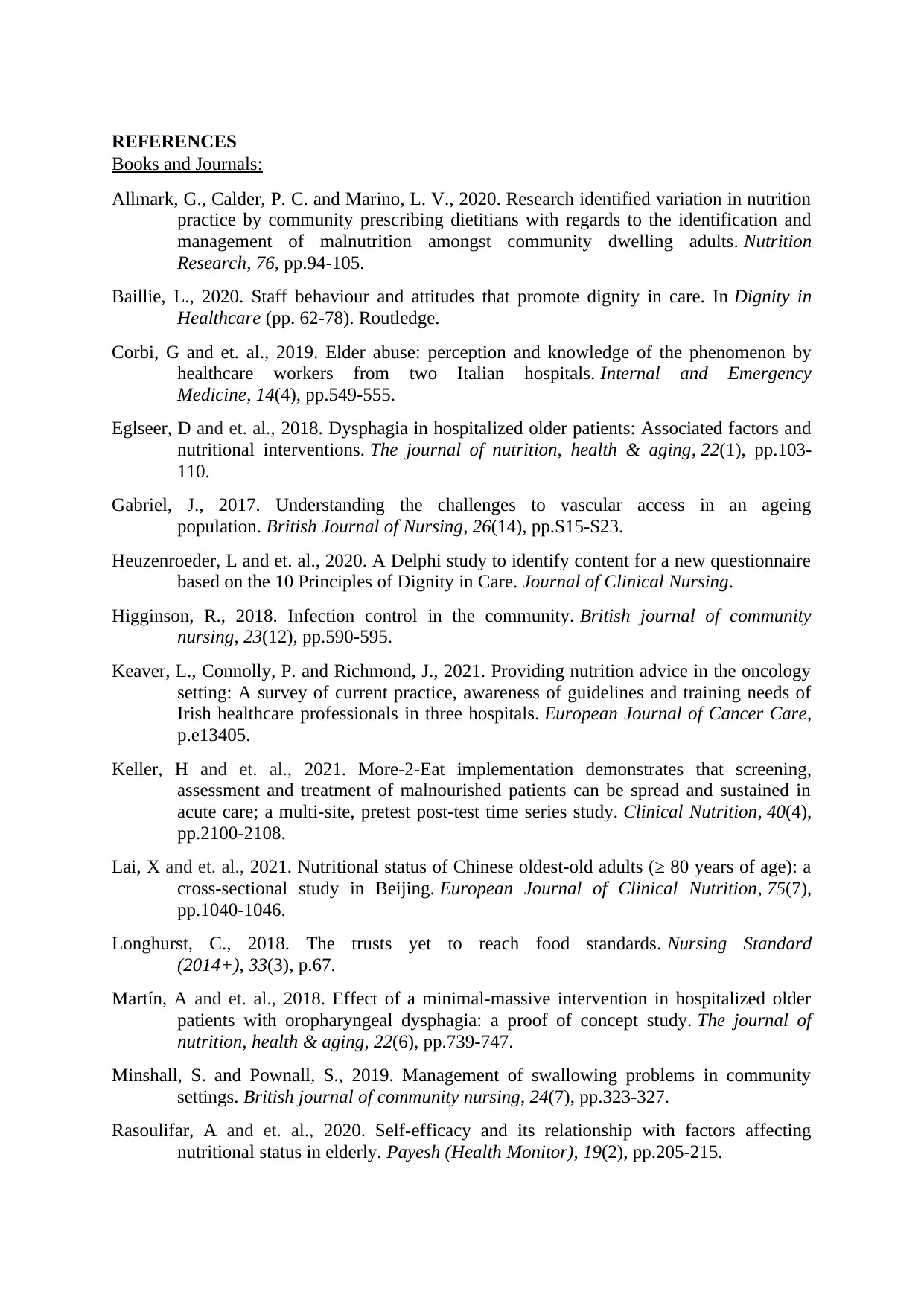
REFERENCES
Books and Journals:
Allmark, G., Calder, P. C. and Marino, L. V., 2020. Research identified variation in nutrition
practice by community prescribing dietitians with regards to the identification and
management of malnutrition amongst community dwelling adults. Nutrition
Research, 76, pp.94-105.
Baillie, L., 2020. Staff behaviour and attitudes that promote dignity in care. In Dignity in
Healthcare (pp. 62-78). Routledge.
Corbi, G and et. al., 2019. Elder abuse: perception and knowledge of the phenomenon by
healthcare workers from two Italian hospitals. Internal and Emergency
Medicine, 14(4), pp.549-555.
Eglseer, D and et. al., 2018. Dysphagia in hospitalized older patients: Associated factors and
nutritional interventions. The journal of nutrition, health & aging, 22(1), pp.103-
110.
Gabriel, J., 2017. Understanding the challenges to vascular access in an ageing
population. British Journal of Nursing, 26(14), pp.S15-S23.
Heuzenroeder, L and et. al., 2020. A Delphi study to identify content for a new questionnaire
based on the 10 Principles of Dignity in Care. Journal of Clinical Nursing.
Higginson, R., 2018. Infection control in the community. British journal of community
nursing, 23(12), pp.590-595.
Keaver, L., Connolly, P. and Richmond, J., 2021. Providing nutrition advice in the oncology
setting: A survey of current practice, awareness of guidelines and training needs of
Irish healthcare professionals in three hospitals. European Journal of Cancer Care,
p.e13405.
Keller, H and et. al., 2021. More-2-Eat implementation demonstrates that screening,
assessment and treatment of malnourished patients can be spread and sustained in
acute care; a multi-site, pretest post-test time series study. Clinical Nutrition, 40(4),
pp.2100-2108.
Lai, X and et. al., 2021. Nutritional status of Chinese oldest-old adults (≥ 80 years of age): a
cross-sectional study in Beijing. European Journal of Clinical Nutrition, 75(7),
pp.1040-1046.
Longhurst, C., 2018. The trusts yet to reach food standards. Nursing Standard
(2014+), 33(3), p.67.
Martín, A and et. al., 2018. Effect of a minimal-massive intervention in hospitalized older
patients with oropharyngeal dysphagia: a proof of concept study. The journal of
nutrition, health & aging, 22(6), pp.739-747.
Minshall, S. and Pownall, S., 2019. Management of swallowing problems in community
settings. British journal of community nursing, 24(7), pp.323-327.
Rasoulifar, A and et. al., 2020. Self-efficacy and its relationship with factors affecting
nutritional status in elderly. Payesh (Health Monitor), 19(2), pp.205-215.
Books and Journals:
Allmark, G., Calder, P. C. and Marino, L. V., 2020. Research identified variation in nutrition
practice by community prescribing dietitians with regards to the identification and
management of malnutrition amongst community dwelling adults. Nutrition
Research, 76, pp.94-105.
Baillie, L., 2020. Staff behaviour and attitudes that promote dignity in care. In Dignity in
Healthcare (pp. 62-78). Routledge.
Corbi, G and et. al., 2019. Elder abuse: perception and knowledge of the phenomenon by
healthcare workers from two Italian hospitals. Internal and Emergency
Medicine, 14(4), pp.549-555.
Eglseer, D and et. al., 2018. Dysphagia in hospitalized older patients: Associated factors and
nutritional interventions. The journal of nutrition, health & aging, 22(1), pp.103-
110.
Gabriel, J., 2017. Understanding the challenges to vascular access in an ageing
population. British Journal of Nursing, 26(14), pp.S15-S23.
Heuzenroeder, L and et. al., 2020. A Delphi study to identify content for a new questionnaire
based on the 10 Principles of Dignity in Care. Journal of Clinical Nursing.
Higginson, R., 2018. Infection control in the community. British journal of community
nursing, 23(12), pp.590-595.
Keaver, L., Connolly, P. and Richmond, J., 2021. Providing nutrition advice in the oncology
setting: A survey of current practice, awareness of guidelines and training needs of
Irish healthcare professionals in three hospitals. European Journal of Cancer Care,
p.e13405.
Keller, H and et. al., 2021. More-2-Eat implementation demonstrates that screening,
assessment and treatment of malnourished patients can be spread and sustained in
acute care; a multi-site, pretest post-test time series study. Clinical Nutrition, 40(4),
pp.2100-2108.
Lai, X and et. al., 2021. Nutritional status of Chinese oldest-old adults (≥ 80 years of age): a
cross-sectional study in Beijing. European Journal of Clinical Nutrition, 75(7),
pp.1040-1046.
Longhurst, C., 2018. The trusts yet to reach food standards. Nursing Standard
(2014+), 33(3), p.67.
Martín, A and et. al., 2018. Effect of a minimal-massive intervention in hospitalized older
patients with oropharyngeal dysphagia: a proof of concept study. The journal of
nutrition, health & aging, 22(6), pp.739-747.
Minshall, S. and Pownall, S., 2019. Management of swallowing problems in community
settings. British journal of community nursing, 24(7), pp.323-327.
Rasoulifar, A and et. al., 2020. Self-efficacy and its relationship with factors affecting
nutritional status in elderly. Payesh (Health Monitor), 19(2), pp.205-215.
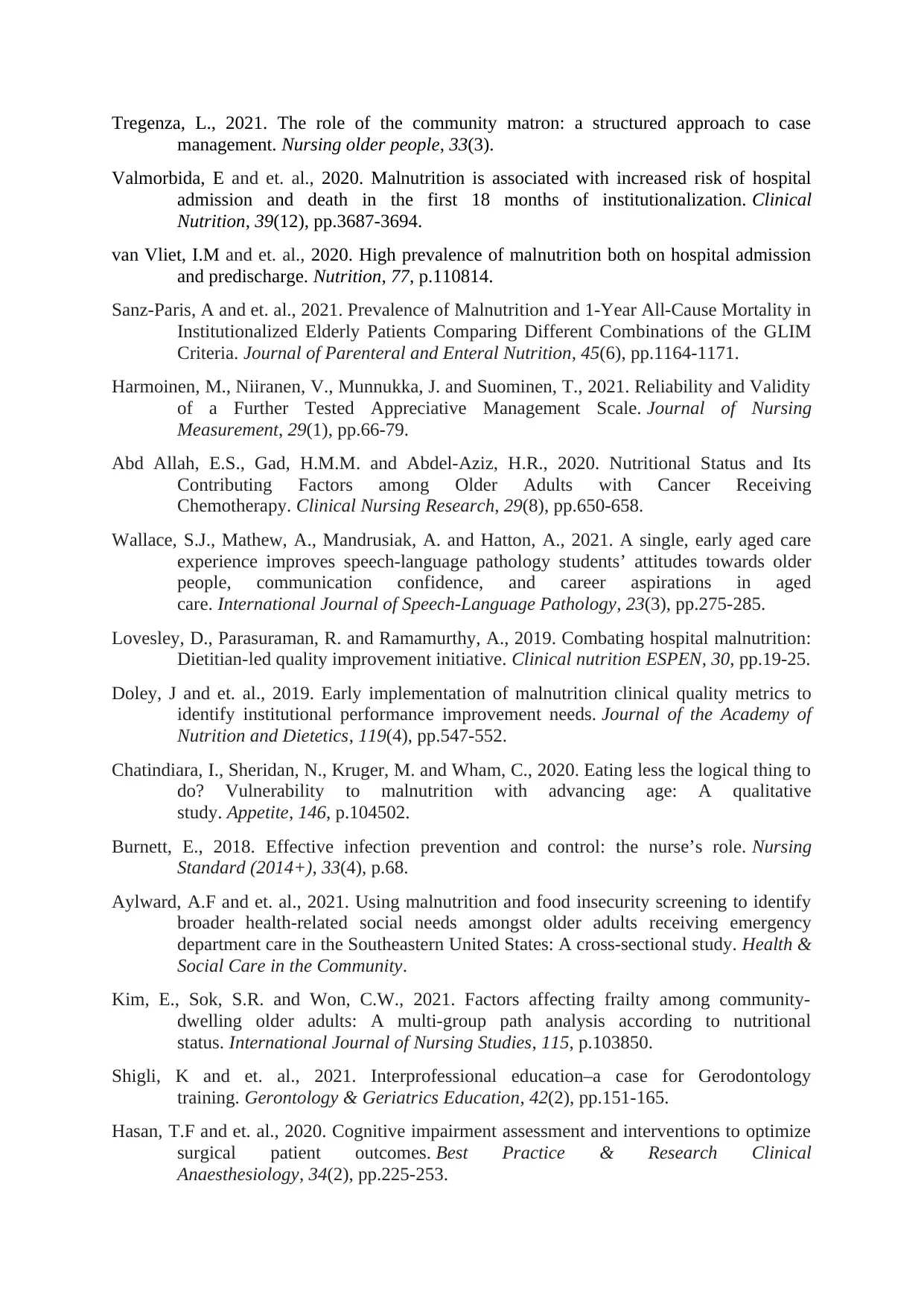
Tregenza, L., 2021. The role of the community matron: a structured approach to case
management. Nursing older people, 33(3).
Valmorbida, E and et. al., 2020. Malnutrition is associated with increased risk of hospital
admission and death in the first 18 months of institutionalization. Clinical
Nutrition, 39(12), pp.3687-3694.
van Vliet, I.M and et. al., 2020. High prevalence of malnutrition both on hospital admission
and predischarge. Nutrition, 77, p.110814.
Sanz‐Paris, A and et. al., 2021. Prevalence of Malnutrition and 1‐Year All‐Cause Mortality in
Institutionalized Elderly Patients Comparing Different Combinations of the GLIM
Criteria. Journal of Parenteral and Enteral Nutrition, 45(6), pp.1164-1171.
Harmoinen, M., Niiranen, V., Munnukka, J. and Suominen, T., 2021. Reliability and Validity
of a Further Tested Appreciative Management Scale. Journal of Nursing
Measurement, 29(1), pp.66-79.
Abd Allah, E.S., Gad, H.M.M. and Abdel-Aziz, H.R., 2020. Nutritional Status and Its
Contributing Factors among Older Adults with Cancer Receiving
Chemotherapy. Clinical Nursing Research, 29(8), pp.650-658.
Wallace, S.J., Mathew, A., Mandrusiak, A. and Hatton, A., 2021. A single, early aged care
experience improves speech-language pathology students’ attitudes towards older
people, communication confidence, and career aspirations in aged
care. International Journal of Speech-Language Pathology, 23(3), pp.275-285.
Lovesley, D., Parasuraman, R. and Ramamurthy, A., 2019. Combating hospital malnutrition:
Dietitian-led quality improvement initiative. Clinical nutrition ESPEN, 30, pp.19-25.
Doley, J and et. al., 2019. Early implementation of malnutrition clinical quality metrics to
identify institutional performance improvement needs. Journal of the Academy of
Nutrition and Dietetics, 119(4), pp.547-552.
Chatindiara, I., Sheridan, N., Kruger, M. and Wham, C., 2020. Eating less the logical thing to
do? Vulnerability to malnutrition with advancing age: A qualitative
study. Appetite, 146, p.104502.
Burnett, E., 2018. Effective infection prevention and control: the nurse’s role. Nursing
Standard (2014+), 33(4), p.68.
Aylward, A.F and et. al., 2021. Using malnutrition and food insecurity screening to identify
broader health‐related social needs amongst older adults receiving emergency
department care in the Southeastern United States: A cross‐sectional study. Health &
Social Care in the Community.
Kim, E., Sok, S.R. and Won, C.W., 2021. Factors affecting frailty among community-
dwelling older adults: A multi-group path analysis according to nutritional
status. International Journal of Nursing Studies, 115, p.103850.
Shigli, K and et. al., 2021. Interprofessional education–a case for Gerodontology
training. Gerontology & Geriatrics Education, 42(2), pp.151-165.
Hasan, T.F and et. al., 2020. Cognitive impairment assessment and interventions to optimize
surgical patient outcomes. Best Practice & Research Clinical
Anaesthesiology, 34(2), pp.225-253.
management. Nursing older people, 33(3).
Valmorbida, E and et. al., 2020. Malnutrition is associated with increased risk of hospital
admission and death in the first 18 months of institutionalization. Clinical
Nutrition, 39(12), pp.3687-3694.
van Vliet, I.M and et. al., 2020. High prevalence of malnutrition both on hospital admission
and predischarge. Nutrition, 77, p.110814.
Sanz‐Paris, A and et. al., 2021. Prevalence of Malnutrition and 1‐Year All‐Cause Mortality in
Institutionalized Elderly Patients Comparing Different Combinations of the GLIM
Criteria. Journal of Parenteral and Enteral Nutrition, 45(6), pp.1164-1171.
Harmoinen, M., Niiranen, V., Munnukka, J. and Suominen, T., 2021. Reliability and Validity
of a Further Tested Appreciative Management Scale. Journal of Nursing
Measurement, 29(1), pp.66-79.
Abd Allah, E.S., Gad, H.M.M. and Abdel-Aziz, H.R., 2020. Nutritional Status and Its
Contributing Factors among Older Adults with Cancer Receiving
Chemotherapy. Clinical Nursing Research, 29(8), pp.650-658.
Wallace, S.J., Mathew, A., Mandrusiak, A. and Hatton, A., 2021. A single, early aged care
experience improves speech-language pathology students’ attitudes towards older
people, communication confidence, and career aspirations in aged
care. International Journal of Speech-Language Pathology, 23(3), pp.275-285.
Lovesley, D., Parasuraman, R. and Ramamurthy, A., 2019. Combating hospital malnutrition:
Dietitian-led quality improvement initiative. Clinical nutrition ESPEN, 30, pp.19-25.
Doley, J and et. al., 2019. Early implementation of malnutrition clinical quality metrics to
identify institutional performance improvement needs. Journal of the Academy of
Nutrition and Dietetics, 119(4), pp.547-552.
Chatindiara, I., Sheridan, N., Kruger, M. and Wham, C., 2020. Eating less the logical thing to
do? Vulnerability to malnutrition with advancing age: A qualitative
study. Appetite, 146, p.104502.
Burnett, E., 2018. Effective infection prevention and control: the nurse’s role. Nursing
Standard (2014+), 33(4), p.68.
Aylward, A.F and et. al., 2021. Using malnutrition and food insecurity screening to identify
broader health‐related social needs amongst older adults receiving emergency
department care in the Southeastern United States: A cross‐sectional study. Health &
Social Care in the Community.
Kim, E., Sok, S.R. and Won, C.W., 2021. Factors affecting frailty among community-
dwelling older adults: A multi-group path analysis according to nutritional
status. International Journal of Nursing Studies, 115, p.103850.
Shigli, K and et. al., 2021. Interprofessional education–a case for Gerodontology
training. Gerontology & Geriatrics Education, 42(2), pp.151-165.
Hasan, T.F and et. al., 2020. Cognitive impairment assessment and interventions to optimize
surgical patient outcomes. Best Practice & Research Clinical
Anaesthesiology, 34(2), pp.225-253.
⊘ This is a preview!⊘
Do you want full access?
Subscribe today to unlock all pages.

Trusted by 1+ million students worldwide
1 out of 13
Related Documents
Your All-in-One AI-Powered Toolkit for Academic Success.
+13062052269
info@desklib.com
Available 24*7 on WhatsApp / Email
![[object Object]](/_next/static/media/star-bottom.7253800d.svg)
Unlock your academic potential
Copyright © 2020–2025 A2Z Services. All Rights Reserved. Developed and managed by ZUCOL.




